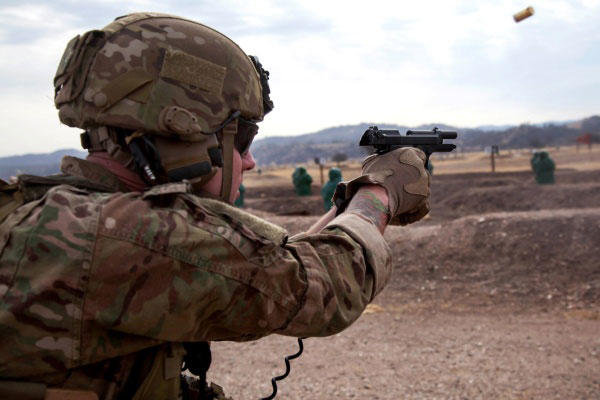The U.S. Army is moving forward to replace the Cold War-era M9 9mm pistol with a more powerful handgun that also meets the needs of the other services.
As the lead agent for small arms, the Army will hold an industry day July 29 to talk to gun makers about the joint, Modular Handgun System or MHS.
The MHS would replace the Army's inventory of more than 200,000 outdated M9 pistols and several thousand M11 9mm pistols with one that has greater accuracy, lethality, reliability and durability, according to Daryl Easlick, a project officer with the Army's Maneuver Center of Excellence at Fort Benning, Ga.
"It's a total system replacement -- new gun, new ammo, new holster, everything," Easlick said.
The Army began working with the small arms industry on MHS in early 2013, but the effort has been in the works for more than five years. If successful, it would result in the Defense Department buying more than 400,000 new pistols during a period of significant defense-spending reductions.
Army weapons officials maintain that combat troops need a more effective pistol and ammunition. But experts from the law-enforcement and competitive shooting worlds argue that tactical pistol ammunition -- no matter the caliber -- is incapable of stopping a determined adversary without multiple shots in most cases.
One of the major goals of the MHS effort is to adopt a pistol chambered for a more potent round than the current 9mm, weapons officials said. The U.S. military replaced the .45 caliber 1911 pistol with the M9 in 1985 and began using the 9mm NATO round at that time.
Soldiers who have served in Iraq and Afghanistan have complained that the 9mm round is not powerful enough to be effective in combat.
"The 9mm doesn't score high with soldier feedback," said Easlick, explaining that the Army, and the other services, want a round that will have better terminal effects -- or cause more damage -- when it hits enemy combatants. "We have to do better than our current 9mm."
The MHS will be an open-caliber competition that will evaluate larger rounds such as .357 Sig, .40 S&W and .45 ACP.
The FBI and several major police departments recently decided to return to using the 9mm round after finding that .40 caliber ammunition was causing excessive wear on its service pistols. The heavier bullet and greater recoil over time resulted in frame damage to well respected makes such as Glock and Beretta, according to Ernest Langdon, a shooting instructor and respected competitive pistol shooter who has worked for gun makers such as Beretta, Smith & Wesson, and Sig Sauer.
"Most of the guns in .40 caliber on the market right now were actually designed to be 9mm originally and then turned into .40 calibers later," Langdon told Military.com.
Langdon served 12 years in the Marine Corps where he was the chief instructor of the Second Marine Division Scout Sniper School and the High Risk Personnel Course. He's been a competitive pistol shooter for 15 years where he has won competitions in the International Defensive Pistol Association and two World Speed Shooting titles.
Larger calibers, such as .40 S&W, have significantly more recoil than the 9mm making them much harder for the average shooter to shoot accurately, he said.
"I don't think anybody would argue that shot placement is the most important for terminal ballistics," Langdon said. "Even though you say a .45 is better than a 9mm, it's still a pistol caliber. Chances are if it is a determined adversary, they are going to have to be shot multiple times regardless of the caliber."
Many law-enforcement shooting incidents have shown this to be reality, he said.
"I talked to a Chicago cop that shot a guy eight times with a .45 to kill him and that was a 230 grain Hydra-Shok," Langdon said. "And that guy now carries a 9mm …he realized that handgun bullets suck. "You have to shoot people a lot with a handgun."
Langdon has trained numerous personnel from all branches of the U.S. military, FBI, Secret Service and other federal agencies as well as state and local law enforcement.
As part of the joint requirement process for MHS, Army weapons officials did a "very thorough cost-benefit analysis" that showed supported the effort, Easlick said.
"We have got an old fleet of M9s right now; it's costing us more to replace and repair M9s than it would cost to go get a new handgun," he said.
The Army spent years on an effort to search for a replacement for its M4 carbine, but ended up adopting the improved M4A1 version used by special operations forces.
Beretta officials maintain that the company has offered to upgrade M9 many times.
"We have submitted numerous changes or product improvements that really address a lot of the shortcomings that are either perceived or real," said Gabe Bailey, Business development manager for Beretta's military division.
The Marine Corps adopted the M9A1 in 2006 that features a rail for attaching lights or lasers, checkering on the front and back of the grip and a beveled magazine well for smoother magazine changes.
Some of the improvements Beretta offered included an enhanced sight system, changing the angle of the slide-mounted safety to avoid inadvertent safety activation and a threaded barrel, Bailey said.
Army officials, however, say the M9 does not meet the MHS requirement.
"The M9 doesn't meet it for a multitude of reasons," Easlick said. "It's got reliability issues; the open slide design allows contaminates in. The slide-mounted safety doesn't do well when you are trying to clear a stoppage -- you inadvertently de-cock and safe the weapon system."
-- Matthew Cox can be reached at Matthew.Cox@monster.com.




























